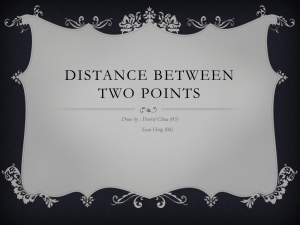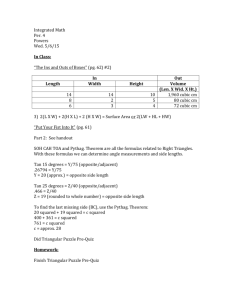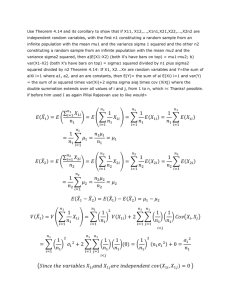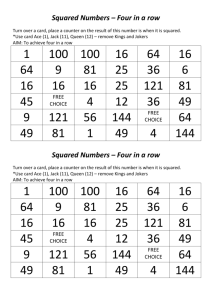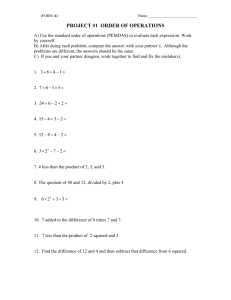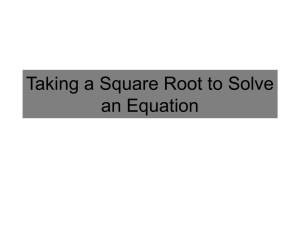LEVEL H LESSON 24 PYTHAGOREAN THEOREM
advertisement
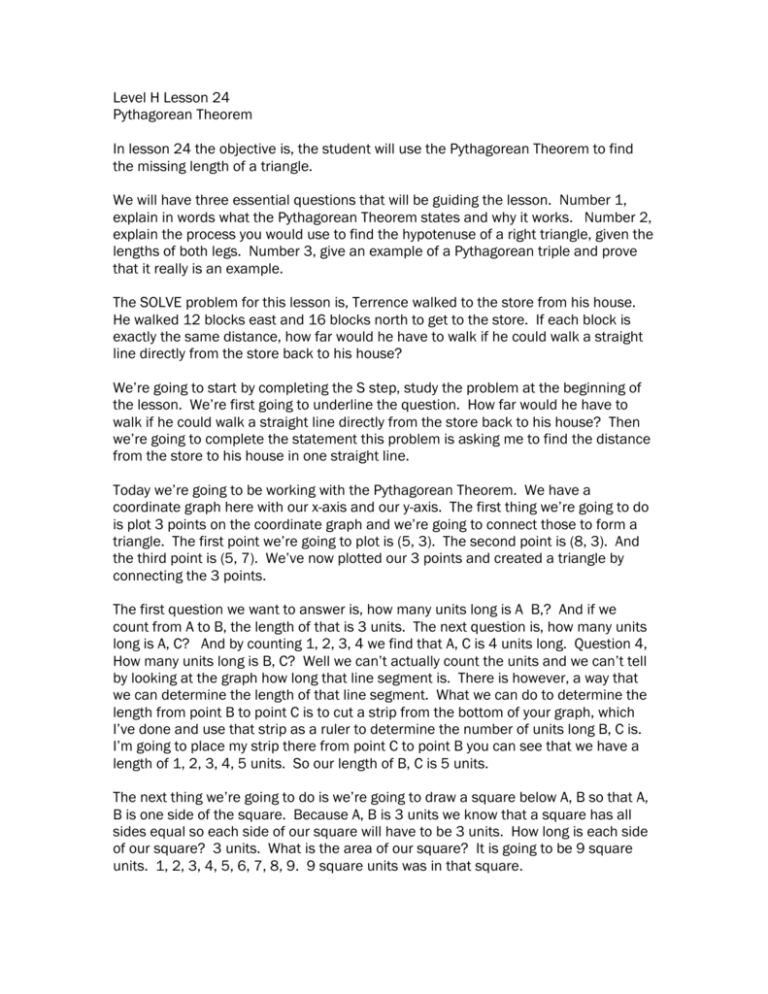
Level H Lesson 24 Pythagorean Theorem In lesson 24 the objective is, the student will use the Pythagorean Theorem to find the missing length of a triangle. We will have three essential questions that will be guiding the lesson. Number 1, explain in words what the Pythagorean Theorem states and why it works. Number 2, explain the process you would use to find the hypotenuse of a right triangle, given the lengths of both legs. Number 3, give an example of a Pythagorean triple and prove that it really is an example. The SOLVE problem for this lesson is, Terrence walked to the store from his house. He walked 12 blocks east and 16 blocks north to get to the store. If each block is exactly the same distance, how far would he have to walk if he could walk a straight line directly from the store back to his house? We’re going to start by completing the S step, study the problem at the beginning of the lesson. We’re first going to underline the question. How far would he have to walk if he could walk a straight line directly from the store back to his house? Then we’re going to complete the statement this problem is asking me to find the distance from the store to his house in one straight line. Today we’re going to be working with the Pythagorean Theorem. We have a coordinate graph here with our x-axis and our y-axis. The first thing we’re going to do is plot 3 points on the coordinate graph and we’re going to connect those to form a triangle. The first point we’re going to plot is (5, 3). The second point is (8, 3). And the third point is (5, 7). We’ve now plotted our 3 points and created a triangle by connecting the 3 points. The first question we want to answer is, how many units long is A B,? And if we count from A to B, the length of that is 3 units. The next question is, how many units long is A, C? And by counting 1, 2, 3, 4 we find that A, C is 4 units long. Question 4, How many units long is B, C? Well we can’t actually count the units and we can’t tell by looking at the graph how long that line segment is. There is however, a way that we can determine the length of that line segment. What we can do to determine the length from point B to point C is to cut a strip from the bottom of your graph, which I’ve done and use that strip as a ruler to determine the number of units long B, C is. I’m going to place my strip there from point C to point B you can see that we have a length of 1, 2, 3, 4, 5 units. So our length of B, C is 5 units. The next thing we’re going to do is we’re going to draw a square below A, B so that A, B is one side of the square. Because A, B is 3 units we know that a square has all sides equal so each side of our square will have to be 3 units. How long is each side of our square? 3 units. What is the area of our square? It is going to be 9 square units. 1, 2, 3, 4, 5, 6, 7, 8, 9. 9 square units was in that square. Next we’re going to draw a square to the left of A, C, so that A, C is one side of the square. How long will each side be? And it needs to be 4 units, because A, C is 4 units long. What is the area of the square we’ve drawn? It is 16 square units. We can count up to determine that or we can also multiply the length of the side times the length of the side which is 4 times 4 or 16. We’re now going to use our line from B to C and we’re going to use our ruler that we’ve made from the coordinate graph and we’re going to draw a square using B, C as that side. So we’ve now drawn our square using the side B, C as our base 5 units, and we’ve used our ruler from our coordinate grid to create a square that has sides that measure 5 units each. The area of the square will be 25 square units, side times side or side squared, 5 times 5 is 25. We have our 3 squares and we’re going to write the three areas. The square we created from A, B, had an area of 9 square units. The square we created from side A, C, had 16 square units. And the square we created from side B, C had 25 square units. Do you see a relationship between the first two and the third numbers? Yes, because the sum of the areas of the first two squares equal the area of the third square. 9 plus 16 is equal to 25. Lets try another. Plot the following points, and then connect them to make a triangle. I plotted point D (negative 5, negative 7), point E at (negative 5, negative 2), and point F at (7, negative 7). Question 11 asks us, how many units long is DE? And if we count from D to E it is 5 units. Question 12, how many units long is DF? And if we count from D to F we have 23 units. Question 13, how many units long is EF? Well unfortunately we can’t tell just by looking at the graph. What we can do however, is use the strip that we’ve cut from the bottom of the page as a ruler to find how many units long E to F is. If we lay our strip on point E and point F we find that we can count 13 units from E to F on our strip. So the measure of EF is 13 units. We will not have room to draw each square using the sides of the triangle like we did in our first example. But since the sides of squares always have the same length you can still figure out the area of each square. What would the area of a square be that had D, E as one of its sides? Because the side is 5 units it would be 25. 5 squared would be 25 What would the area of a square be that had DF as one of its sides? It would be 12 squared or 12 times 12 which is 144. What would be the area of a square be that had EF as one of its sides? Remember we found that E, F had a measure of 13. So 13 squared would be 169 square units. We’re going to start by writing the three areas. 25, 144, 169. Do you see a relationship between the three numbers? Remember that in our first triangle the relationship was that the square of this side plus the square of this side equaled the square of the third side. Let’s see if that holds true here. Yes, the sum of the areas of the first two squares equals the area of the third square. 25 plus 144 equals 169. The Pythagorean Theorem states that there is a relationship between the side lengths of a right triangle. Remember this relationship only exists when we’re using a right triangle. A triangle that has one angle that is a right angle that measures 90 degrees. Let’s try and write the theorem: How did we get the numbers of 9, 16, and 25 in Problem 9 and 25, 144 and 169 in Problem 18? These were the areas of the squares we made form the sides of the triangles. How did we find the area of the square? Remember we took the side and we multiplied it by itself or we squared it. So we multiplied a side by a side, or side squared. So, if the legs were sides a and b, and the hypotenuse (which is always the longest side of the triangle and across from the right angle) was side c, what equation could you write to relate the areas of the three squares? Our equation then for the Pythagorean Theorem is a squared plus b squared equals c squared, or the area of the square with side a plus the area of the square with side b equals the area of the square with side c. We’re now going to be working with Pythagorean Theorem to find the missing side length. We’re going to start by using our first example which a triangle which has been plotted on the coordinate plane or the Cartesian Plane. We have side a, which if I count the number of units I’m going to find that side a, is 6 units. I have side b, going to count those, and I find that side b, has 8 units. However, remember I cannot determine side c, just by counting or looking at the drawing. So what I’m going to do is I’m going to use my Pythagorean Theorem to determine the missing hypotenuse length. The side across from the right angle is the hypotenuse or we’re going to call that side c. So I have my formula which is a squared plus b squared equals c squared. I’m going to substitute in my value of side a which is 6, I’m going to add to that my value of b squared and that is going to give my hypotenuse of c squared. 6 squared which is 6 times 6 is a value of 36. b squared which is 8 squared has a value of 64, that’s going to give me the value of my hypotenuse squared. 36 plus 64 is 100, c squared which is my hypotenuse or side c. C squared is going to be a value of 100. In order to determine what c is, I’m going to have to do the opposite of squaring which is finding the square root. C will be equal to the square root of 100. I know that the square root of 100 is 10. Because 10 times 10 is 100. Side c has a value of 10 units. Our second example is a Pythagorean Theorem practice without the Cartesian Plane. We have a right triangle. We know it’s a right triangle because we have marked a right angle there, and the side opposite that we’re going to identify as side c or our hypotenuse. We’ll call the side with the 8 a, and the 15-side b. We’re going to use our formula for Pythagorean Theorem, a squared, plus b squared equals c squared. We’re going to substitute in the value for a, which is 8, we’re going to add to that b squared and that’s going to give us our hypotenuse squared. 8 squared is 64, 15 squared is 225, that’s going to give us c squared. When we add these two values together we have a total of 289. Because that’s the value of our hypotenuse squared. We’re going to have to find the square root of c squared, which is c. And we’re going to find the square root of 289. The square root of 289 is 17. Because 17 times 17 is 289. So the value for side c is 17 centimeters. In our last example we’re going to use the Pythagorean Theorem but this time we are given the hypotenuse, and we’re given one leg. So we’re going to identify our leg a, we already have b identified here, and remember our hypotenuse we always identify as c. We know that a squared is 10 squared. I’m going to write that. We do not know the value of b this time so we’re just going to put b squared. We do however know that c has a value of 26 and we’ll square that. 10 squared is 100, plus b squared, equals 26 squared which is 676. When you begin working with these larger numbers this is a great place for your students to practice if they need calculator practice either squaring or using the square root. As in any equation we need to isolate our variable. Because we are adding 100 to the left side we’re going to subtract 100 and we’re going to subtract 100 from the right side. We have b squared now isolated and equal to 576. We need to find the value of b. The square root of b squared would be b, and we need to find the square root of 576. The square root of 576 is 24. So our value for b is 24 centimeters. We’re now going back to the SOLVE problem from the beginning of the lesson. Terrence walked to the store from his house. He walked 12 blocks east and 16 blocks north to get to the store. If each block is exactly the same distance, how far would he have to walk if he could walk a straight line directly from the store back to his house? We’ve completed the S step from the beginning of the lesson. We’ve underlined the question and we’ve completed the statement this problem is asking me to find, the distance from the store to his house in a straight line. We’re now moving to the O step. We’re going to organize our facts. The first thing we do is identify our facts. Terrence walked to the store from his house, that’s one fact. He walked 12 blocks east, that’s a second fact. And 16 blocks north to get to the store, that’s another fact. If each block is exactly the same distance, that’s our last fact. Then we’re going to go back through and eliminate any unnecessary facts. Terrence walked to the store from his house. We’re going to cross that out because that does not contain any information to help us determine how far he would have to walk. He walked 12 blocks east, that a necessary fact. 16 blocks north, is another necessary fact. Each block is exactly the same distance, that our last necessary fact. We then complete the O step by listing those. 12 blocks east, 16 blocks north, blocks are all equal distance. In the L step we’re going to line up our plan. We’re going to start by choosing an operation. We actually have multiple steps we’re going to do. We’re going to be multiplying, we’re using addition and we’re going to be using square roots. My plan of action is to draw a picture of the blocks he walked, then make a diagonal line to make a triangle. Use the Pythagorean Theorem to find the hypotenuse. In the V step we’re going to go ahead and work our plan. We first have to have an estimate. Our estimate here is that the number of blocks will be greater than 18. We’re now going to carry out our plan. I’ve drawn a triangle to represent the situation from our problem. We have from the house he’s walking 12 blocks directly east. He then turns and walks north 16 blocks to the store. We connect those two points and we create a triangle. Remember this is a right triangle because he’s walking east and then north. We don’t know the distance from the house to the store along the hypotenuse but we’re going to use the Pythagorean Theorem. A squared we’re going to identify as the blocks he walked to the east. B squared is the distance he walked to the north. A squared plus B squared equals C squared. We substitute in our values and we find that the distance of C squared is 400. When we find the square root of C squared determined he walked 20 blocks if he goes directly from the store to the house. In the E step we’re going to examine our results. The first thing we want to determine is, does your answer make sense? And you compare your answer to the question. Our answer was 20 blocks, and yes, it does make sense, because I found the distance from the store to his house. Is your answer reasonable? Compare your answer to the estimate. Our estimate was more than 18. Yes, I thought the distance would be greater than 18 blocks, and it is. Is your answer accurate? We can go back and check our work. Write your answer in a complete sentence. The distance from the store to Terrence’s house is 20 blocks. We now go back to answer our essential questions from the beginning of the lesson. Explain in words what the Pythagorean Theorem states and why it works. The square of one leg length plus the square of the other leg length equals the square of the hypotenuse length. It works, because if you make squares using the length of each side of the triangle, the two smaller square areas equal the larger square area giving you a squared plus b squared equals c squared. Explain the process you would use to find the hypotenuse of a right triangle, given the lengths of both legs. Substitute the length of one leg in for a and the other in for b in the Pythagorean Theorem. Square both numbers, then add. Find the square root of the sum. Give an example of a Pythagorean triple and prove that it really is an example. Answers may vary but one possible answer is 3, 4, 5; 3 squared plus 4 squared equals 5 squared; 9 plus 16 equals 25. Since this statement is true, 3, 4, 5 works with the Pythagorean Theorem and is a triple.
